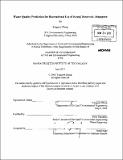| dc.contributor.advisor | Peter Shanahan. | en_US |
| dc.contributor.author | Zhang, Yangyue | en_US |
| dc.contributor.other | Massachusetts Institute of Technology. Dept. of Civil and Environmental Engineering. | en_US |
| dc.coverage.spatial | a-si--- | en_US |
| dc.date.accessioned | 2011-11-01T19:52:15Z | |
| dc.date.available | 2011-11-01T19:52:15Z | |
| dc.date.copyright | 2011 | en_US |
| dc.date.issued | 2011 | en_US |
| dc.identifier.uri | http://hdl.handle.net/1721.1/66848 | |
| dc.description | Thesis (M. Eng.)--Massachusetts Institute of Technology, Dept. of Civil and Environmental Engineering, 2011. | en_US |
| dc.description | Cataloged from PDF version of thesis. | en_US |
| dc.description | Includes bibliographical references (p. 52-57). | en_US |
| dc.description.abstract | Singapore has been making efforts in relieving its water shortage problems and has been making great progress through its holistic water management. Via the Active, Beautiful, Clean Waters (ABC Waters) Programme, Singapore's Public Utilities Board (PUB) is now aiming to opening Kranji Reservoir for recreation. Considering the potential contamination of freshwater, particularly by fecal coliform, which threatens public health by causing water-borne diseases, a practical microbial water quality prediction program has been built up to evaluate the safety of the recreational use of Kranji Reservoir. E. coli bacteria concentrations within the reservoir were adopted as an indicator of recreational water quality. Dynamic fate-and-transport modeling of E. coli concentrations along the reservoir was carried out using the Water Quality Analysis Simulation Program (WASP). The model was constructed by specifying basic hydraulic parameters. E. coli loadings were indexed to the various land uses within the Kranji Catchment and the effective E. coli bacterial decay rates were derived from theoretical equations and verified by on-site attenuation studies carried out in Singapore. Simulation results from the WASP model are consistent with samples collected and analyzed for E. coli concentration in Kranji Reservoir in January 2011. The simulation results indicate potentially high risk in using the reservoir's three tributaries for water-contact recreation. The model also shows advective flow through the reservoir to be a big contributor to the concentration changes along the reservoir. A prototype of a practical early warning system for recreational use of Kranji Reservoir has been designed based on the implementation of the model. | en_US |
| dc.description.statementofresponsibility | by Yangyue Zhang. | en_US |
| dc.format.extent | 63 p. | en_US |
| dc.language.iso | eng | en_US |
| dc.publisher | Massachusetts Institute of Technology | en_US |
| dc.rights | M.I.T. theses are protected by
copyright. They may be viewed from this source for any purpose, but
reproduction or distribution in any format is prohibited without written
permission. See provided URL for inquiries about permission. | en_US |
| dc.rights.uri | http://dspace.mit.edu/handle/1721.1/7582 | en_US |
| dc.subject | Civil and Environmental Engineering. | en_US |
| dc.title | Water quality prediction for recreational use of Kranji Reservoir, Singapore | en_US |
| dc.type | Thesis | en_US |
| dc.description.degree | M.Eng. | en_US |
| dc.contributor.department | Massachusetts Institute of Technology. Department of Civil and Environmental Engineering | |
| dc.identifier.oclc | 757994261 | en_US |
